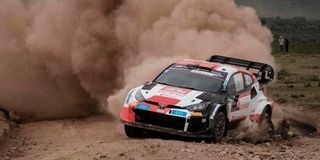Premium
Dramatic photo finish at Sardinia Rally just what WRC ordered

France's Sebastien Ogier and co-driver France's Vincent Landais steer their Toyota GR Yaris Rally1 Hybrid during the WRC Safari Rally in Kenya on June 23, 2023.
What you need to know:
- Tanak was destined to a second-place finish in last weekend's WRC Sardinia Italy.
- Sebastien Ogier turned on the pressure and ended the day with maximum 18 points.
Ott Tanak, the Estonian 2019 world rally champion is a very lucky man.
He is also and a good example of how fickle and unpredictable rallying is.
Tanak was destined to a second place finish in last weekend's WRC Sardinia Italy behind Frenchman eight times world champion Sebastien Ogier until 3km from the finish in the very last section when he took the lead with the smallest margins possible, almost a dead heat finish.
Tanak was only concerned about scoring construction championships points for Hyundai Motorsports while safeguarding his second overall position.
His team had earlier intervened and urged him to gun for the constructors points for Hyundai instead of taking unnecessary risks trying to challenge Ogier for the lead after Saturday's action.
Tanak was the quickest driver in the morning loop on Saturday. But Ogier turned on the pressure to win the afternoon loop and end the day with maximum 18 points, three better than the Estonian and with a 17.1 seconds lead.
But Tanak did not relent and whittled this lead to 6.02seconds as the drivers entered the Sassari Power Stage before drama unfolded.
Ogier suffered a puncture 3km from the finish of the stage, and lost by two tenths of a second (0.2), or simply put being edged out in an Olympics 100 metres photo finish dash.
Winning time
Tanak’s 0.2 seconds winning time equalled a similar margin between Ogier and Toyota Gazoo racing team principal Jari-Matti Latvala in 2011 WRC Jordan. The Frenchman was the victor.
This is the second time Ogier has lost Sardinia at the same stage after the 2019 misfortune when he suffered steering problems.
These results also confirm how evenly matched the current generation of WRC drivers have become and also the surge and form of the Hyundai car and team this season.
However, the highlight of Sardinia was the successful implementation of recommendations done by a work group appointed by the FIA last December to make the WRC more attractive and competitive.
The group proposed varied changes which will make each round of the WRC distinctive and divided into sprints and endurance on one side; and also characterised by the prevailing geographical and climatic conditions of each leg.
This has divided the WRC into asphalt, tarmac and ice.
This year’s Sardinia was the third round of the asphalt rallies after WRC Safari Rally and WRC Portugal.
Conditions were dry but some sections really rough like the stage which knocked off current championship leader Belgian Thierry Neuville on Saturday.
New sprint format
He was forced to retire but rejoined the rally on Sunday to safeguard his points lead which was reduced by six by Elfyn Evans.
Neuville has 122 points and Evans 104, same as Tanak. Ogier has 92 and Adrien Fourmaux of France 74.
The rally, though tough, was also reduced to a 48 hours sprint in a new format, which, if it proves popular will turn the WRC into a two and a half days affair instead of three to four days as has been the tradition with all WRC rounds.
Meanwhile, Saudi Arabia joined the WRC circuit from 2026, and for the next 10 years.
Rally Saudi Arabia promises to showcase the country’s diverse and challenging landscapes on surfaces ranging from volcanic rock to sandy desert terrain, providing a novel test for crews with conditions never previously encountered in WRC history.
While Saudi Arabia is a newcomer to the WRC, it boasts a proven track record with a multitude of international sporting events hosted there including the Dakar Rally, Formula 1, football, and golf.
HRH Prince Khalid Bin Sultan Al Abdullah Al-Faisal, Chairman of the Saudi Automobile and Motorcycle Federation and the Saudi Motorsport Company, was delighted to welcome WRC to Saudi Arabia.





